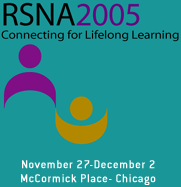
Abstract Archives of the RSNA, 2005
Janna Z. Andrews MD, Presenter: Nothing to Disclose
Hans Chung MD, Abstract Co-Author: Nothing to Disclose
Vivian Weinberg PhD, Abstract Co-Author: Nothing to Disclose
Katsuto Shinohara MD, Abstract Co-Author: Nothing to Disclose
Mack Roach MD, Abstract Co-Author: Nothing to Disclose
Purpose/Objective: It is well known that 50% of men presenting with a palpable nodule on DRE do not have prostate cancer on biopsy but rather have hyperplastic nodules. Most studies accept the development of a nodule on DRE following radiotherapy as evidence of local recurrence with or without biochemical failure. The purpose of this study is to determine whether the development of a palpable nodule on DRE after RT is an appropriate endpoint for defining local recurrence and directing subsequent treatment. Materials/Methods: This analysis is based on 109 consecutive prostate cancer patients who underwent biopsies for suspected local recurrences after being treated with either external beam radiation (EBRT) (n=101) or Brachytherapy (n=4), or a combination of both (n=4). All patients were treated between 1982-2002, with curative intent. These patients were suspected of having local recurrence based either on an abnormal DRE, a rising PSA, or both. All of these patients were subsequently examined and biopsied under transrectal ultrasound guidance by a single urologist (SK). All pathology was reviewed at UCSF. A subset analysis was performed on patients with palpable nodules on DRE found to be biopsy (Bx) positive (+) or negative (-). Follow up data was obtained on biopsy negative patients to determine if they had locally recurred. Results: Most patients presented with palpable nodules or rising PSA 2-10yrs after completion of definitive radiation therapy. Forty percent (n=43) of the patients had a palpable nodule on DRE and a median PSA at time of biopsy= 4.17 ng/ml, (Range= 0.1-11.38 ng/ml). Of these patients with a palpable nodule 44% (n=19) had a (+) Bx, and 19% (n=8) had (-) Bx. There was no significant difference in median PSA at time of biopsy between these two groups (3.8 ng/ml and 3.97ng/ml, respectively). Of patients with a (-) Bx, six had extensive follow up ranging from 3-7years (median follow up was 3.5 years), and median PSA at time of last follow up was 1ng/ml. Based on PSA kinetics, three of these patients were placed on HT, one patient underwent salvage brachytherapy, and the remaining two are still under observation with no documented evidence of recurrence. Two patients were rebiopsied annually twice, one patient was rebiopsied annually three times, and all pathology was negative for recurrence. The remaining 37% (n=16) of patients were not biopsied after ultrasound but were empirically placed on observation (n=7) or HT (n=9)with a median PSA of 3.48 ng/ml at the time of ultrasound. Conclusions: Although the development of a palpable nodule in a site previously documented to contain disease is worrisome, a significant number of prostate cancer patients appear to develop benign hyperplastic nodules. Since 'benign bounces' of the PSA have been noted to occur in 20 to 30% of patients treated with radiotherapy there are likely to be occasional patients who have a slight increase in PSA and a palpable nodule who in fact have two benign events. Awareness of this phenomena is important because: (1) in a population of low risk patients for whom recurrences are relatively uncommon it may represent a large percentage of false + recurrences; (2) patients with (+) Bx may be candidates for salvage treatments like salvage prostatectomy, brachytherapy, or cryosurgery. It is probably appropriate to consider patients with rapidly rising PSAs as candidates for systemic therapy but a bounce in the PSA even in the presence of a palpable nodule should not be considered conclusive evidence of local recurrence.
Andrews, J,
Chung, H,
Weinberg, V,
Shinohara, K,
Roach, M,
Digital Rectal Exam (DRE) Is an Insufficient Means for Assessing Local Recurrence after Radiotherapy for Prostate Cancer. Radiological Society of North America 2005 Scientific Assembly and Annual Meeting, November 27 - December 2, 2005 ,Chicago IL.
http://archive.rsna.org/2005/4420762.html

